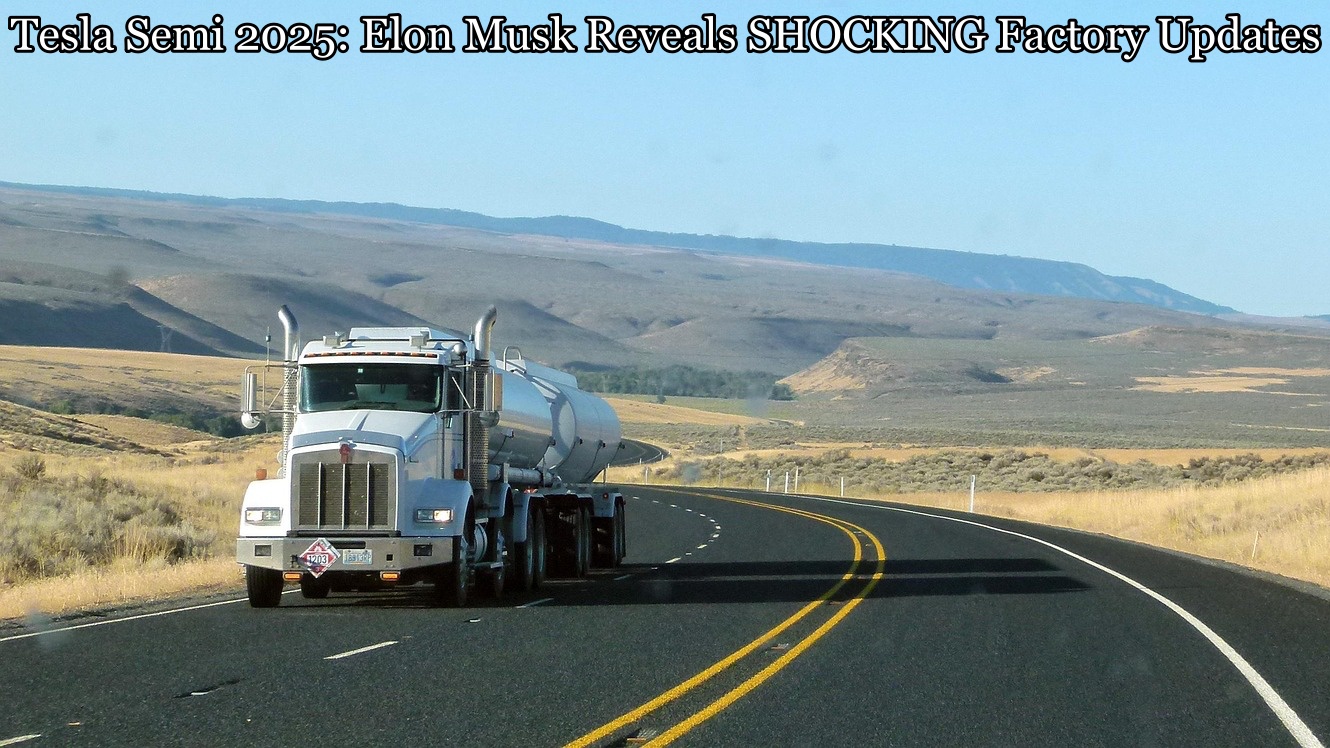2025 is shaping up to be a landmark year for Tesla as the company sets its sights on revolutionizing the trucking industry with the highly anticipated Tesla Semi. The new Giga Semi factory, set to begin full-scale operations next year, is expected to take Tesla’s production capabilities to new heights.
Let’s take a deep dive into what the future holds for the electric semi-truck market.
Tesla Semi Production: Breaking Records
Can you believe that Tesla will take only 10 to 15 minutes to produce a semi-truck by next year? This rapid production timeline will be achievable thanks to the Giga Semi factory’s cutting-edge technology. Although the semi-truck remains one of Tesla’s most challenging vehicles to manufacture, the new factory’s innovations make this speed possible.
By the end of 2025, Tesla aims to produce at least 10,000 units, with a target of 50,000 units by 2026. While hitting the 50,000 mark may be ambitious, there’s one thing we know for sure—Tesla will be delivering thousands of Semi trucks to customers by the end of this year.
Tesla’s commitment to delivering all pending orders is essential for customers who have been waiting for years. As Elon Musk has pointed out, businesses that aren’t using the Tesla Semi might be missing out on massive profits due to the vehicle’s efficiency, fuel savings, and reduced maintenance costs. The Tesla Semi isn’t just a transport vehicle; it’s a money-making machine.

Customization and Incredible Performance
One of the most exciting aspects of the Tesla Semi is its customization options. Depending on customer needs and budget, the Semi can be tailored for different applications. Early adopters have consistently reported outstanding performance, with the Semi exceeding expectations on the road.
By 2026, Tesla aims to dominate the trucking industry by proving that electric trucks can replace diesel trucks. As the electric truck revolution accelerates, get ready for exciting updates about this innovative big rig.
Giga Semi and Tesla’s Production Facilities
While Giga Semi will not be completed until the end of the year, Giga Nevada is already producing small batches of Tesla Semi trucks. Evidence of this can be seen in numerous new trucks spotted outside the parking lot, which are likely being used internally to transport batteries from Fremont.
Elon Musk has emphasized that with accelerated progress, the first Tesla Semi trucks will begin production no later than Q4 2025, possibly even earlier in Q3. Tesla’s 4 million square foot factory, which is backed by a $3.6 billion investment, is about 65% complete as of now.
Henrik Zayn, a key observer, reports that the company is speeding up construction at the stamping pit where large stamping machines will be installed for mass manufacturing. The construction process is well underway, and Tesla is rapidly increasing production capabilities to meet demand.
Tesla’s Ambitious Goals and Future Production
Looking forward, Tesla plans to manufacture 50,000 second-generation Semi trucks annually at its new facility, with a daily output goal of over 135 trucks. As production speeds increase, Tesla could soon reach a pace of one truck every 5 minutes. While this is an ambitious goal, Tesla’s innovative approach and past success make it highly achievable.
In comparison, top truck brands like Kenworth and Peterbilt sold a combined 190,000 heavy-duty trucks in 2023. With 50,000 semis per year, Tesla’s target production is just a small fraction of the total market. However, if Tesla can scale up production even further, they have the potential to revolutionize the trucking market.
Tesla’s Eco-Friendly Edge: Lower Costs, Lower Emissions
When you think of Tesla’s Semi, it’s clear that this vehicle isn’t just about technology—it’s also about saving money and helping the environment. Operating costs for a Tesla Semi are far lower than those of traditional diesel trucks. While a diesel truck runs at an average of $1.51 per mile, the Tesla Semi costs only 85 cents per mile.
These savings become even more apparent over time. For example, a business with a fleet of Tesla Semis could save up to $200,000 in just three years. Early adopters like PepsiCo and DHL have already seen the financial benefits, with zero interest in returning to diesel trucks.
Tesla’s low maintenance costs are another key factor. Without the internal combustion engine and bulky transmission systems of traditional trucks, maintenance for a Tesla Semi costs just 10 cents per mile—significantly less than a diesel truck.
The Future of Electric Trucks
The Tesla Semi is changing the game not only in terms of operational efficiency but also in terms of sustainability. Heavy-duty trucks may make up only 1% of all vehicles on the road, but they are responsible for 20% of global emissions. Transitioning to electric trucks is a critical step toward creating a more sustainable transportation industry.
Countries like California are already mandating a shift to zero-emission trucks by 2042, and the Tesla Semi is leading the way. In just over a decade, diesel trucks could be a thing of the past, and Tesla’s Semi is spearheading the revolution.
The Tesla Semi: A Global Leader in Electric Transportation
As Tesla ramps up production, the company is focusing on scaling its semi-production and expanding its mega-charger network to support its electric truck fleet. The Mega Chargers will provide faster charging times, making the transition to electric trucking even more practical for businesses.
Beyond cost savings, the Tesla Semi offers an unparalleled driving experience. It’s faster, safer, and more powerful than any diesel truck on the road. With features like traction control, rollover protection, and full self-driving technology, the Tesla Semi not only enhances performance but also improves driver safety and efficiency.
Is the Tesla Semi the Future of Trucking?
It’s clear that the Tesla Semi is poised to become a dominant force in the electric trucking industry. With massive cost savings, superior performance, and environmental benefits, Tesla is setting the stage for a future where electric trucks are the standard rather than the exception.
In the next decade, diesel trucks may become a rarity, while electric trucks like the Tesla Semi will reshape the landscape of the transportation industry. Are you ready for the change?
FAQ
Tesla aims to produce a Semi truck every 10 to 15 minutes once the Giga Semi factory goes into full operation in 2025. This will allow Tesla to scale production significantly, with an annual target of 50,000 units by 2026.
While Tesla has already delivered some early models, the wider availability of the Tesla Semi will begin in 2025. Tesla plans to deliver at least 10,000 units by the end of 2025.
The Tesla Semi offers substantial cost savings, improved fuel efficiency, reduced maintenance costs, and a cleaner, sustainable alternative to diesel trucks. Its advanced features, including safety technology and quicker acceleration, provide an unparalleled driving experience for long-haul trips.
The Tesla Semi is priced between $180,000 and $250,000, depending on the configuration. While this is higher than the cost of a traditional diesel truck, the long-term savings on fuel and maintenance make it a financially smart investment.
Maintenance for a Tesla Semi costs around 10 cents per mile, significantly lower than the 20 cents per mile cost of a diesel truck. Over a 5-year period, this can save a business up to $50,000 in maintenance costs.
With Tesla’s Mega Chargers, it takes just 40 minutes to fully charge a Tesla Semi, which is comparable to the refueling time of a diesel truck when considering break and unloading times.
The Tesla Semi can travel up to 500 miles on a single charge, even while hauling cargo. This range is perfect for long-haul trucking and surpasses the capabilities of many electric trucks on the market.
Yes! Tesla Semis are designed to accommodate a range of cargo needs, and the trucks are customizable depending on the customer’s requirements and budget.
Yes, the Tesla Semi is a significant step toward reducing emissions in the trucking industry, which contributes 20% of global emissions. Transitioning to electric trucks helps reduce air pollution and move toward a more sustainable transportation system.
Tesla plans to ramp up production of the Semi to 50,000 trucks per year by 2026. The company is also developing multiple versions of the Semi to meet the needs of different industries and customers, ensuring it leads the transition to electric trucking.
Read More:


Dear Elon:
I am 81 and my wife of 61 years is 80. We desperately need an Optimus Gen3 as a companion, caregiver, and first responder. We want to be on the rent-to-buy list. We have looked into having a human come for 40 ours a week to help us with household chores and assistance with dressing and mobility needs. Those humans (Visiting Angels) charge $45 an hour, which equates to about $90K per year. Far beyond our fixed income.
If our doctor prescribes an Optimus Gen3, would our medical insurance help with the cost? We have a friend who is having trouble finding and hiring an accountant. If she purchased an Optimus Gen3 to do accounting, would she be able to write off the cost of her robot?
Please put my wife and me on the rent/buy pre-order list.